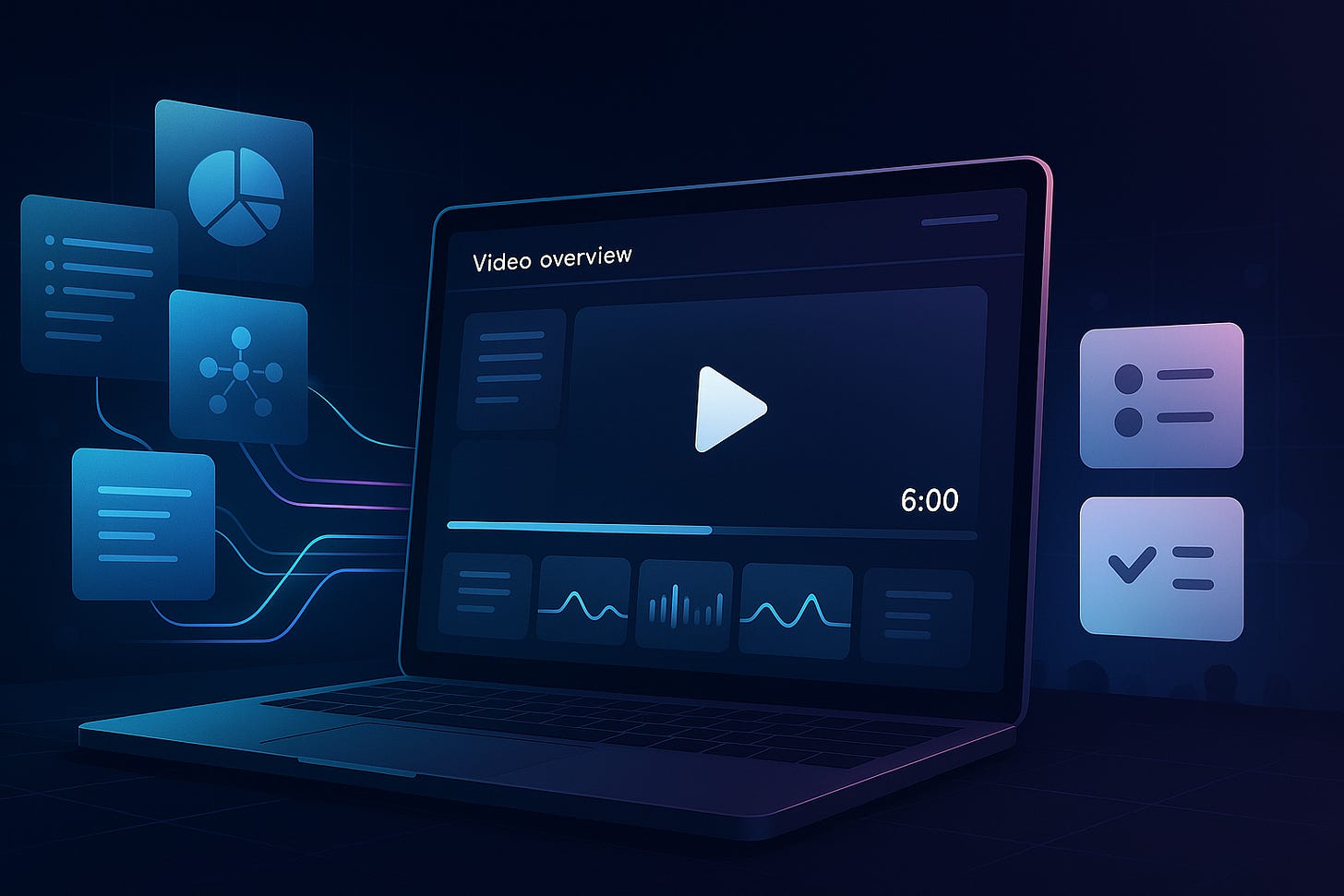Last week, I fed ten hours of my AI workshop content into NotebookLM's brand-new video creation feature. What came out was both impressive and revealing about where AI content creation is heading for business leaders who want to transform how their organizations share knowledge.
When NotebookLM first launched, I was genuinely stunned by the audio podcast feature. Hearing two AI hosts have a natural, engaging conversation about my uploaded documents felt like magic. They didn't just read my content aloud; they discussed it, debated nuances, and explained complex concepts in ways that made me think, "I wish I had explained it that clearly." It was groundbreaking in a way that made me rethink how we could transform written content into consumable formats.
That initial experience set the bar incredibly high and showed me what was possible when AI truly understood context rather than just processing text.
So when Google announced video capabilities, I knew I had to test it immediately with substantial content. I uploaded the markdown files from both my "Art of the Possible" AI workshop, a focused 2-3 hour session that covers AI foundations and business applications, and my comprehensive full-day AI Mastery training program. Together, these materials represent approximately ten hours of content, covering a range of topics from technical concepts such as tokens and context windows to hands-on exploration of tools like ChatGPT, Claude, and Custom GPTs, as well as strategic business implementation frameworks.
The result? A six-minute video that covered the main concepts from my workshops in a coherent way. It was good, definitely usable, but it wasn't the jaw-dropping experience I had with the audio feature. The AI successfully identified key themes across both workshops and structured them logically; however, it condensed ten hours of content into just six minutes, resulting in the loss of a lot of nuance and depth. Still, watching it, I could see executives staying engaged and getting real value from the overview it provided.
But here's where it gets interesting for business leaders. The video wasn't just technically competent; it highlighted a crucial aspect of where this technology is headed. We're not just talking about another content creation tool here. This is about fundamentally changing how organizations package and deliver knowledge, and it's happening faster than most executives realize.
Consider your training materials at this moment. How much institutional knowledge sits locked away in documents, presentations, and lengthy guides that nobody has time to read? I've seen this across every organization I work with, from Fortune 500 companies to fast-growing startups. Critical information exists, but it's trapped in formats that don't match how people actually consume information today. Compliance training sits unread, onboarding materials gather digital dust, and policy updates get skimmed at best.
NotebookLM's video feature starts to solve this problem in ways that should excite any executive thinking about internal communications and training efficiency. Instead of expecting employees to dig through a hundred-page onboarding manual, you could transform that content into engaging video summaries that new hires will actually watch and retain. Rather than hoping people will read through policy updates, you could create focused video explanations that people will actually engage with during their commute or lunch break.
This isn't just about convenience, it's about ROI. When training materials are actually consumed and understood, you see faster time-to-productivity for new hires, better compliance across the organization, and more effective knowledge transfer from senior employees to junior staff.
The current limitations are significant, though. Transitions between topics felt abrupt and jarring, the six-minute output meant that complex topics got oversimplified, and the depth that makes training truly valuable was largely missing. The visual elements remain basic, and the content selection felt arbitrary in places. This isn't yet the comprehensive training solution you might hope for, but it's an impressive foundation that shows clear potential.
What struck me most was the potential I could see in how the AI approached the content. It didn't just randomly sample from my materials; it attempted to synthesize information across multiple documents and create a narrative flow. The execution was solid for a first attempt, though it definitely felt more like a promising proof of concept than a finished product. You can clearly see where this technology is heading, even if it's not quite there yet.
For business leaders, the opportunity is more about understanding the trajectory than implementing perfect solutions today. The technology is accessible right now, and you don't need technical expertise to start experimenting. Take some of your existing content and see what NotebookLM produces. You won't get a polished training video ready for company-wide deployment, but you'll get a clear sense of where this is heading and how it might transform your approach to internal communications.
The technology isn't perfect yet, but it's advancing rapidly. Organizations that start experimenting with these capabilities now will have a significant advantage as the tools mature. More importantly, you'll begin to understand how AI can transform the way you package and deliver knowledge within your organization.
Don't wait for perfection. Start testing, learning, and adapting. The future of internal communications is being written right now, and early adopters will shape how it develops.
Thanks for reading. If you enjoyed this and are not a subscriber, please subscribe. If you found this interesting, please share it with your friends.
If you have a moment, please take a look at my updated website at https://intelligencebyintent.com/ - I would love to hear your thoughts/feedback!





